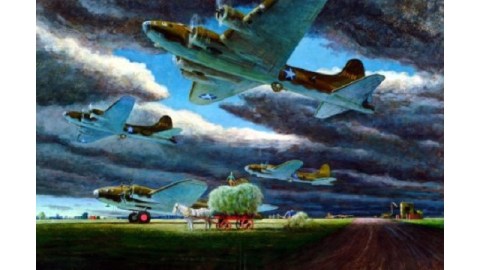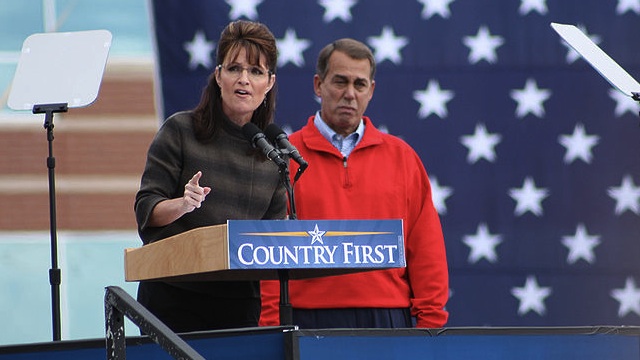War and Peace: The Art of the American Soldier

The modern view of the American soldier at war is invariably shaped by television. Beginning with the Vietnam War, the first war brought literally into the living rooms of private citizens halfway around the world from the actual shooting, even the most remote conflict seems nearby thanks to modern technology. Since the very beginning of the fighting in Iraq and Afghanistan, when news cameras literally rode in the first wave of tanks, those conflicts, too, have been defined by the immediacy of video (and, perhaps, even lost to public consciousness in the sea of images that assault us daily). Art of the American Soldier, an exhibition at the National Constitution Center in Philadelphia, PA, restores the human touch and human vision to the daily experience of men and women in combat. Finally brought out of storage, many of these images have never been seen by the public before, and may never have been needed to be seen by the public before as they need to be now.
In March 1943, George Biddle, a former soldier and artist selected to head the Army’s Art Advisory Committee, wrote a memorandum (on view in the exhibition) to the soldier-artists heading overseas during World War II. Biddle implores them to “record the war in all its phases, and its impact on you as artists and as human beings.” “[A]ny subject is in order,” Biddle continues, “the nobility, courage, cowardice, cruelty, boredom of war; all this should form part of a well-rounded picture.” This “well-rounded picture” comes to life in the selection of more than 200 works of art in a variety of mediums culled from a collection of more than 15,000 paintings and sketches created by over 1,300 American soldiers since the beginning of the army’s art program during World War I.
The curators organized the exhibition into five sections: an introduction; A Soldier’s Life; A Soldier’s Duty; A Soldier’s Sacrifice; and The American Soldier. If there can be anything approaching a theme to such a wide-ranging show both in terms of geography and time, it would have to be the powerful sense of contradictions the mind of the soldier needs to face in the theater of war. Floyd Davis’ painting of Bob Hope entertaining troops during World War II with a helmet perched awkwardly on his head captures beautifully the juxtaposition of the comforts of home life inserted momentarily and precariously among the terrors of uncertain survival in battle. Another amazing painted “snapshot” of two worlds colliding takes place in Peter Hurd’s 1942 War and Peace (shown above). Hurd, a war correspondent for Life during World War II, emphasizes the relentless rhythm of bomber planes rising into the sky on a mission to Europe as farmers bale hay from a horse-driven cart. Agricultural and industrial, horse-driven and horse-power, coexist beneath leaden skies that seem as solid paths as the dirt road traveled by the farmers to the barn in the distance. Hurd is best known today as the brother-in-law of Andrew Wyeth who first taught young Andy the egg tempera painting techniques that would one day spawn enduring works such as Christina’s World. Just as Wyeth’s mesmerizing and confounding image a crippled woman struggling across a field demands attention, Hurd’s painting, and so many others in this exhibition, grip you with the power of the determination of people simply trying to survive in a world seemingly conspiring against them.
This exhibition not only reconnects the public to the military past, but it also strives to reconnect the public to the soldiers of the present. Veterans can submit artwork through the website to a special online gallery that will be displayed on a monitor inside the exhibition space. In addition, visitors can thank today’s soldiers at a letter-writing station at the end of the exhibition space. In return for filling out a postcard, visitors receive a free music CD titled Breaking Southern Ground (featuring the Zac Brown Band, Sonia Leigh, Nic Cowan, and Levi Lowrey) as part of the “Letters for Lyrics” program. Finally, Art of the American Soldier serves as the first wave of The Army Historical Foundation’s campaign to create a National Museum of the United States Army.
“When a war poses for its picture, it leaves to the artist the selection of the attitude in which the artist may desire to draw it,” wrote World War I soldier-artist J. Andre Smith in 1919. “And this attitude is the artist’s point of view circumscribed by the boundaries of his ability and the nature of the work for which his training and practice have fitted him.” Even when the technical skill of the artists in this exhibition seems challenged, you can always sense the meeting of the greater challenge of capturing the human experience in warfare in all its terror, boredom, and confusion. For those of us who have never experienced that in our lives, Art of the American Soldier brings the reality home in a way that no televised newscast ever could.
[Image: Peter Hurd. War and Peace. World War II, 1942.]
[Many thanks to the National Constitution Center in Philadelphia, PA for providing the image above from the exhibition Art of the American Soldier, which runs through January 10, 2011.]





